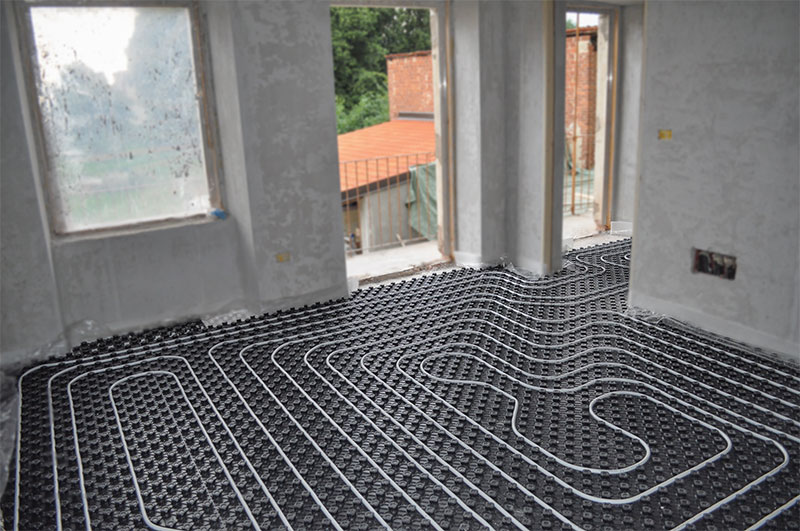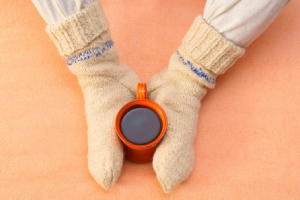This is a guest blog from Adam Brundell, an expert underfloor heating installer. Adam is the founder of Circa Installations & the Floor Heat Store with years of experience in heated floors installation.
Ask most people why they’ve chosen to install heated floors and you’ll find it’s because it is an energy efficient, safe and reliable heating system. In this blog post, I will share some of the top tips on how to install underfloor heating that I have learned during the years as an underfloor heating installer. Whether you’re a professional installer or an enthusiastic DIYer, I hope you’ll find these tips useful.
>> Additional expert tips to install heated floors.
CHOOSING BETWEEN ELECTRIC AND HYDRONIC HEATED FLOORS
Modern underfloor heating systems are divided into wet (or “hydronic”) and dry, or electric. Dry systems are generally simpler and they run on mains electricity, whereas wet systems use a loop of pipes carrying water and are connected to the boiler or another heat source. In terms of issues with installing heated floors, a competent DIYer shouldn’t have any major problems installing either system, though wet systems may be more complex.
LOCATION WILL ALSO IMPACT YOUR CHOICE
Your choice of system is affected by where it’s going to go to. New constructions are well suited to wet systems, as underfloor heating pipe is often embedded in new concrete floors, whereas the cables and mats that make up electric systems can be laid on top of the subfloor, before being covered with whatever flooring has been chosen. With tiled floors, the cables will be sealed with tile adhesive. Wood and laminate flooring, vinyl and carpets can also be used with the system.
HELP WITH CHOOSING A HEATED FLOOR SYSTEM
If you are not sure which type is best suited to your project, contact a qualified electrician or Warmup for advice on the suitability of a chosen system, and to discuss any remedial works which should take place before your installation commences. Warmup, as the world’s best-selling floor heating brand, is a great choice for the system. You should beware of cheaper alternatives made from low-quality products and always ensure that you are buying a genuine product from an authorized Warmup reseller to ensure the best value for money.
>> Check which system you should use with your final floor covering.
TIPS TO INSTALL HEATED FLOORS SUCCESSFULLY
Clean the subfloor before installing underfloor heating pipe
Modern pipes used in wet systems are tough and durable. However, clean the subfloor thoroughly before installation and the laying of the underfloor heating pipes to get rid of any jagged edges that could damage them. You may need to lay a damp-proof membrane on the subfloor before installing the insulation layer that comes with the kit.
The pipe attaches to a simple set of units that hold it in position so that each loop is at the specified distance – generally between 200mm and 250mm apart, depending on the type of floor. The maximum length of pipe that can be used in any one room is about 100-110m.
Install the manifold first with wet underfloor heating systems
With wet systems, the manifold – the unit to which the pipe loop is connected in a particular room – should be the first thing that’s installed. You’ll need to account for the weight of the unit and for the pipes that are eventually connected when choosing a mounting site.
With electric underfloor heating, it’s necessary to get a qualified electrician at least to make the mains connection in order to comply with BS7671- 2008 and current IEE wiring regulations.
Be mindful of maximum temperatures and the final flooring
One of the most important things to consider is the kind of finished flooring that will be laid over the system as some floor covers have a top temperature restriction. Vinyl floors have a maximum temperature limit of 80°F (27°C) degrees, as do carpet, laminate and wood floors.
Improve efficiency by insulation
I can’t emphasize enough how important installing Warmup insulation boards is. A lot of people try to save money and not bother with underfloor insulation, but it has massive benefits from decreased heat-up time to energy savings and lower running costs in the long term.
Plan and measure
Planning is essential so measure out the area and plan for the installation carefully. My tip is to take your time with this as it will make for a much quicker installation in the long run.
Make sure to consider all the fixtures and fittings that are going to be installed. For instance, with a bathroom installation your toilet pans, pipe work for heated towel rails and radiators have to be fixed to the floor. All this needs to be taken into account when installing the system as to avoid damage to the heating wire when the above are being fitted. Also, ensure your existing subfloor is free from dust and dirt and, if it’s a wooden subfloor, check that there are no squeaky floorboards as fixing this afterward will not be easy.
>> Should you tile under or around the toilet when installing heated floors?
Test underfloor heating
It is very important that you test the system before and after all stages of the installation. If you are unsure, just ask your electrician to do this before the final floor covering goes down.
Also remember that all Warmup systems come with a SafetyNet™ Installation Guarantee which means that if the heater is damaged during installation, it will be replaced free of charge giving you that extra piece of mind when installing the system.
BONUS TIP: PROTECT YOUR NEW SYSTEM
When laying underfloor heating mat, lay the mat with wires facing down to the subfloor and the mesh up this will give greater protection to the heating wire during installation. Always follow manufacturing guidelines or seek professional advice if in doubt.
And finally, if the final floor covering is going to be tiles or ceramic, I would always recommend using a flexible self-levelling latex or a flexible tile adhesive to cover the underfloor heating mat with a scratch coat as this helps the tile installation.
Unsure of what products to you use in your next underfloor heating installation? Take a look at the Warmup Underfloor Heating Product Selector for easy reference.





![Thumbnail [200x250]](/wp-content/uploads/Indoor-Systems-Page-Image.png)
![Thumbnail [200x250]](/wp-content/uploads/image-13.png)
![Thumbnail [200x250]](/wp-content/uploads/Projects-Image.png)